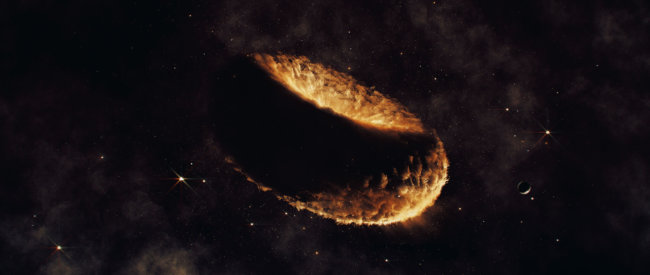
13 December 1972, astronaut “Apollo-17” Harrison Schmitt walked up to the boulder in the sea of Tranquility on the moon. “This boulder has its own little path leading directly to the hill,” he said to his commander Eugene Cernan, noting where there was a boulder before you slide down the slope. Cernan took a few samples.
“Imagine what would happen if you stood there before he rolled the boulder”, thoughtfully said Cernan. “Perhaps I’d better not”, said Schmitt.
The astronauts cut the pieces of the moon boulder. Then, using a rake, Schmitt scraped the dusty surface and picked up a stone, which would later be called “troctolite 76536”.
That stone and his brothers-boulders was to tell the story of how was born our moon. In this story of creation recorded in countless textbooks and scientific Museum exhibits over the past forty years, the Moon was melted from a catastrophic collision between the Earth the germ and the hard world the size of Mars. Another world called Theia, after the Greek goddess who gave birth to Selene, the moon. So much Theia crashed into the Earth that both the world melted. Theia ejected flow of molten material is then cooled and hardened, forming a silvery companion, whom we all know well.
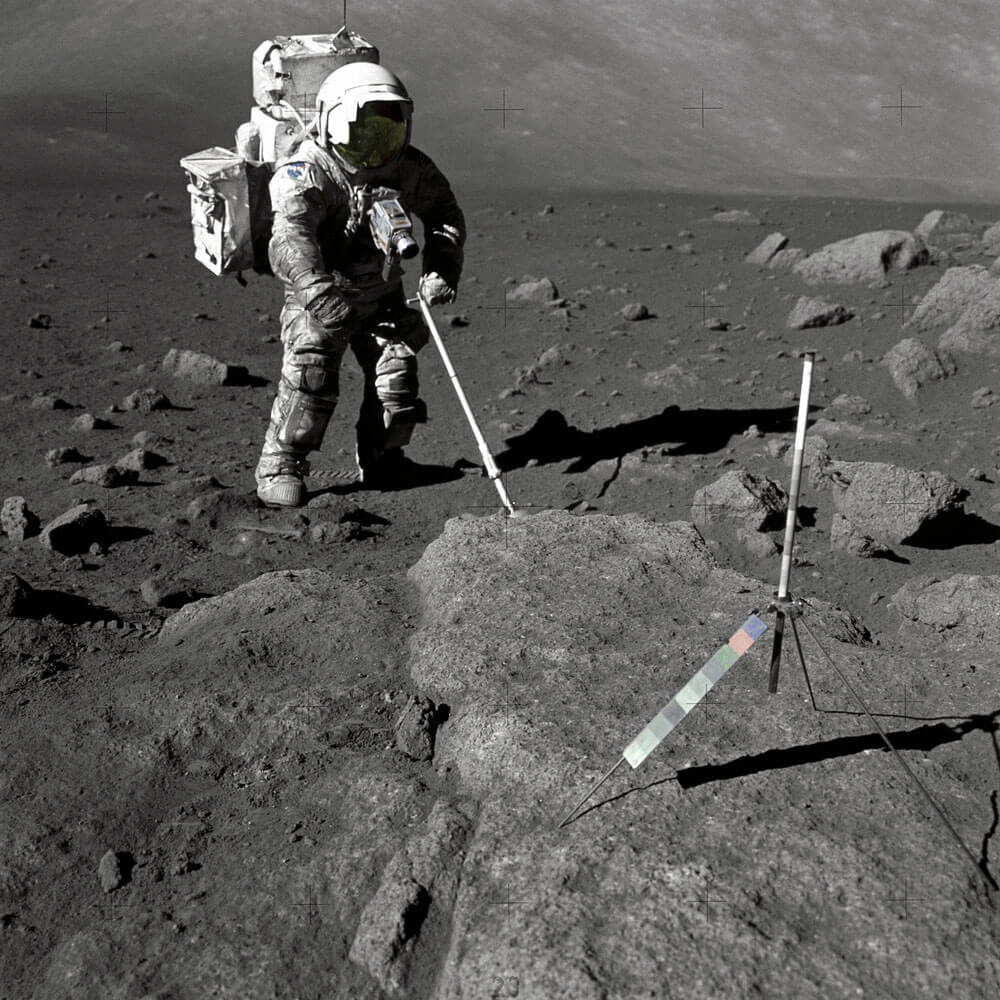
But modern measurements of troctolite 76536 and other rocks from the moon and Mars have questioned this theory. Over the last five years a lot of research revealed the problem: the canonical giant impact hypothesis is based on assumptions that do not match the evidence. If Theia hit the Earth, and later formed the moon, the Moon must be made of the material theis. But the Moon is not like the Theia — or Mars for that matter. To the atoms she looks almost the same as Earth.
Faced with this discrepancy, the lunar explorers looking for new ideas, to understand how the moon appeared. The most obvious solution may be the easiest, but it creates other problems with the understanding of the young Solar system: possible, Theia formed the moon, but the main course also consisted of a substance that is almost identical to earth. Another option is the collision of a mixed all, homogenizing the individual pieces and liquid in cake which is then cut into portions. In this case, the collision had to be extremely powerful, or they had to be several. A third explanation calls into question our understanding of the planets. Could it be that the Earth and Moon that we have today have gone through a strange metamorphosis and wild orbital dances that have radically changed their rotation and future.
Bad news for theis
To understand what could happen in the most important for Earth day, you need to start with an understanding of the youth of the Solar system. Four and a half billion years ago the Sun was surrounded by a hot cloud of debris in the shape of a donut. The star elements are rotated around our newborn sun, cooling down and — for many years — merging together in a process that we do not fully understand. First in clumps, then into planetesimals, then planets. These solids hard and often experienced, vanished and appeared again. It is in this incredibly hard star Billiards were forged by the Earth and Moon.
To get the same moon that we have today, with its size, rotation, and speed at which it moves away from Earth, our best computer models say that it ran into Earth, that something must be the size of Mars. Something more or less would produce a system with much more angular momentum than we are seeing. Shell more also would have thrown too much iron in the Earth’s orbit and would produce much more iron-rich moon than we observe.
The first geochemical studies of troctolite 76536 and other species confirmed this story. They showed that the moon rocks must have been born in the lunar magma ocean, which could, in turn, be the result of a giant impact. Troctolite swim in the molten sea as an iceberg in Antarctica. Based on these physical limitations, scientists have decided that the Moon was made out of the remains of theis. But there is a problem.
Back to the young Solar system. As soon as the solid worlds have met and evaporated, the contents were mixed, finally settling in certain regions. Closer to the Sun where it was hotter, more light elements were more likely to heat up and run away, leaving an excess of heavy isotopes (variations of elements with extra neutrons). Farther from the Sun rocks had the ability to hold more water and left the lighter isotopes. Therefore, the scientist can explore a mixture of isotopes, to determine which part of the Solar system, it appeared like the focus to be the birthplace of man.
These differences are so pronounced that they are used for the classification of planets and types of meteorites. Mars so different from Earth, for example, that his meteorites can be identified by a simple measurement of the correlation between the three different isotopes of oxygen.
In 2001, using advanced techniques of mass spectrometry, Swiss scientists had re-examined troctolite 76536 and other lunar samples. It turned out that their oxygen isotope indistinguishable from those on Earth. Geochemists have since studied titanium, tungsten, chromium, rubidium, potassium and other not quite ordinary metals on Earth — and they all looked almost the same.
This is bad news for theis. If Mars is so different from Earth, Theia, and the Moon must also be different. If they are the same, it means that the moon was formed from molten pieces of Land. Breeds, collected by “Apollo”, comes out, will directly contradict that insists physics.
“The canonical model is in serious crisis,” says Sarah Stewart, a planetary scientist at the University of California, Davis. “She hasn’t killed completely, but its current status is that it doesn’t work”.
The moon from steam
Stewart tried to reinvent the physical constraints of this problem — the need to shock the body a certain size that moves with a certain speed on the background of the new geochemical evidence. In 2012, she and Matija beetle, now working at the SETI Institute, has proposed a new physical model of the formation of the moon. They stated that the young Earth was a spinning dervish, a day which lasted two or three hours, when it was struck by Theia. The collision produced the disc around the Earth — as the ring of Saturn — but that only lasted 24 hours. In the end, the disk cooled and solidified, forming the moon.
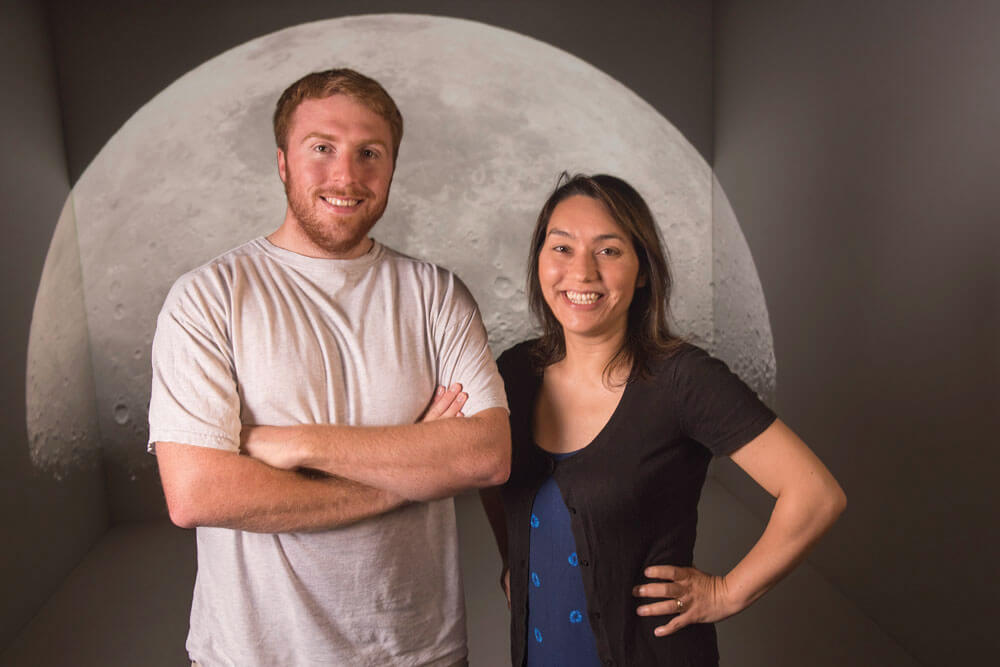
Supercomputers are not powerful enough to fully emulate this process, but they showed that the projectile crashing into this rapidly spinning world, may cut off a sufficient quantity of Land, completely destroying Theia and scrape off the skins with enough of both to create the moon and the Earth with the same isotope ratios. As a Potter on a Potter’s wheel.
To the explanation with the fast rotating Earth was true, however, there must be something else slowing down the speed of rotation of the planet to its current state. In their work, the 2012 Stewart and PAAs argued that, under certain orbital resonance interaction the Earth had to transfer angular momentum to the sun. Later, Jack Wisdom of the Massachusetts Institute of technology have proposed several alternative scenarios for the extraction of angular momentum from the system Earth-Moon.
However, no single explanation was not satisfactory. 2012 models and could not explain the orbit of the moon or its chemistry, says Stewart. And so, last year, Simon Locke, a graduate of Harvard University and student of Stuart at the time, introduced an updated model, which suggested a previously proposed planetary structure.
In his opinion, every piece of Land and theis evaporated and formed a bloated, swollen cloud in the form of a thick bagel. The cloud was spinning so fast that we reached the point called the limit of the joint rotation. On this outer edge of the cloud of vaporized rock circling so fast that the cloud had adopted a new structure, with a thick disk encircling the inner region. Importantly, the disk has not been separated from the Central region as separated by the rings of Saturn.
The conditions in this structure indescribable hell; there is no surface, instead of a cloud of molten rock, and each region of clouds forms rain drops from molten rock. The moon rose within the pair, says Locke, before the steam is finally cooled and left behind the system Earth — Moon.
Given the unusual characteristics of the structure, Locke and Stuart felt that it deserves a new name. They tried out several versions before coming to “sinesti”, which uses the Greek prefix “SYN” meaning “together,” and the goddess Hestia, which represents the home, hearth and architecture. This word means “connected structure,” says Stewart.
“These bodies are not what you think. And they don’t look the way you thought they would look”.
In may, Locke and Stewart published a paper about the physics sinesti; their work on the theme sinesti lunar origin is still under consideration. They presented it at a conference of planetary scientists and said that their colleagues were interested, but hardly agree with the idea. Perhaps because sinesti is just the idea; in contrast to ringed planets, which many in the Solar system, and protoplanetary disks, many of which are in the Universe, no one never seen.
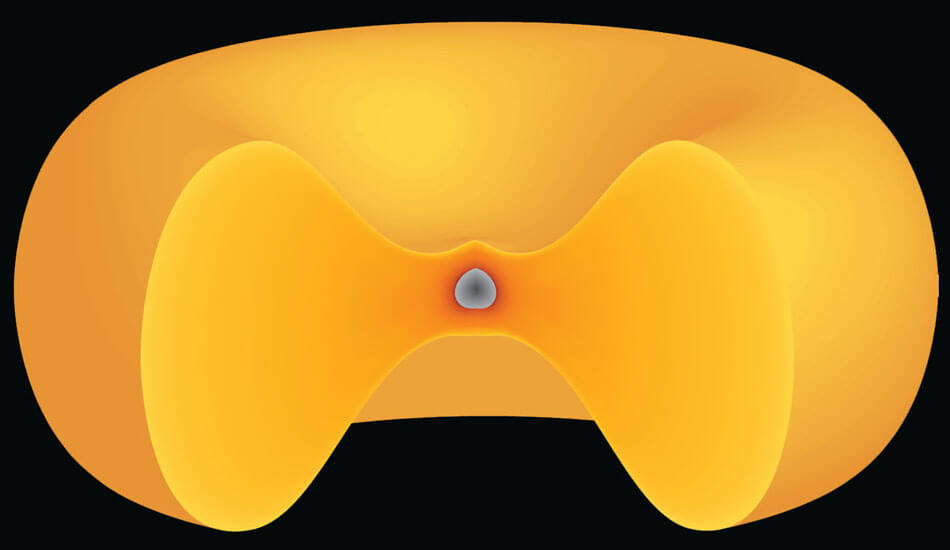
But it is an interesting way to explain the features of our moon, when our models don’t seem to work.
Ten moons
Among the natural satellites of the Solar system, earth’s Moon may be the most amazing because of its loneliness. Mercury and Venus has no natural satellites, in part due to their proximity to the sun, the gravitational influence of which makes the satellite orbits are unstable. Mars has tiny Phobos and Deimos, which some believe are captured asteroids; others speak in favor of falls of large bodies on Mars. The gas giants have many satellites, both hard and soft.
Unlike these satellites, a satellite of the Earth also stands out for its dimensions and physical burden that carries. The moon is less than 1% of the Land mass and the total mass of the satellites of the outer planets — at least 1/10 percent of their parents. More importantly, the moon account for 80% of the angular momentum of the Earth —
Moon. In other words, the Moon is responsible for 80% of the movement system as a whole. For the outer planets this value is less than 1%.
Perhaps the Moon was not always carrying all that load. The face of the companion shows evidence of heavy bombardment; why, then, should we assume that only one blow molded the moon from the Earth? Perhaps the Moon was formed during the many clashes, says Raluca Rufus, a planetary scientist, the Weizmann Institute in Israel.
In a paper published last winter, she claimed that the moon may not be original. Instead, it became a collection of thousands of pieces — at least ten, based on its calculations. Shells flew at different angles and at different speeds on the Earth and formed discs that were merged in “the wreckage of the moon”, in the end, having made the moon that we know today.
Planetary scientists have noted her work. Robin Canup, monolog southwest research Institute and an expert on the theories of lunar formation, says that the theory is worthy of consideration. However, more research is needed. Rufus I’m not sure whether moving these fragments in one direction, just as the Moon always looks in the same direction. If so, how did they all merge? It remains to be seen.
Meanwhile, others have turned to another explanation of the similarity of the Earth and the moon, which could have a very simple answer. From sinesti to the moon belt, new physical models and new physics can be controversial. Perhaps the Moon is similar to Earth only because Theia was similar.
The same
The moon is not the only earthly thing in the Solar system. Breed like troctolite 76536 have the same ratio of oxygen isotopes as the earth rocks and asteroid groups — enstatite chondrites. The composition of oxygen isotopes of these asteroids are similar to earth, says Myriam Telus, cosmogenic studying meteorites at the Carnegie institution in Washington. “One of the arguments is that they were formed in hot regions of the disk, which could be closer to the sun,” she says. Maybe they formed near the Ground.
Some of these breeds have gathered to form the Earth; others formed the main course. Enstatite chondrites is residual stones, which are never intended and do not become large enough to form a mantle, a core and a fully formed planet.
In January, Nicholas Dauphas, a geophysicist at the University of Chicago, said that most of the stones that became the Earth were meteorites enstatite type. He argued that all that is formed within the region, will be collected from them. Planetary construction took place using the same mixed materials that we now find on Earth and the moon; they look the same because they are one and the same. Giant body that formed the moon probably had an isotopic composition similar to the earth.
David Stevenson, a planetary scientist from the California Institute of technology, studies the origin of the moon since then, as a hypothesis theis was first introduced in 1974, says that he considers this work the most important contribution to the dispute over the last year. Because she is devoted to the problem, which geochemists are trying to solve for decades.
“This is a clever story about how we need to consider the different elements that fall on the Ground,” says Stevenson.
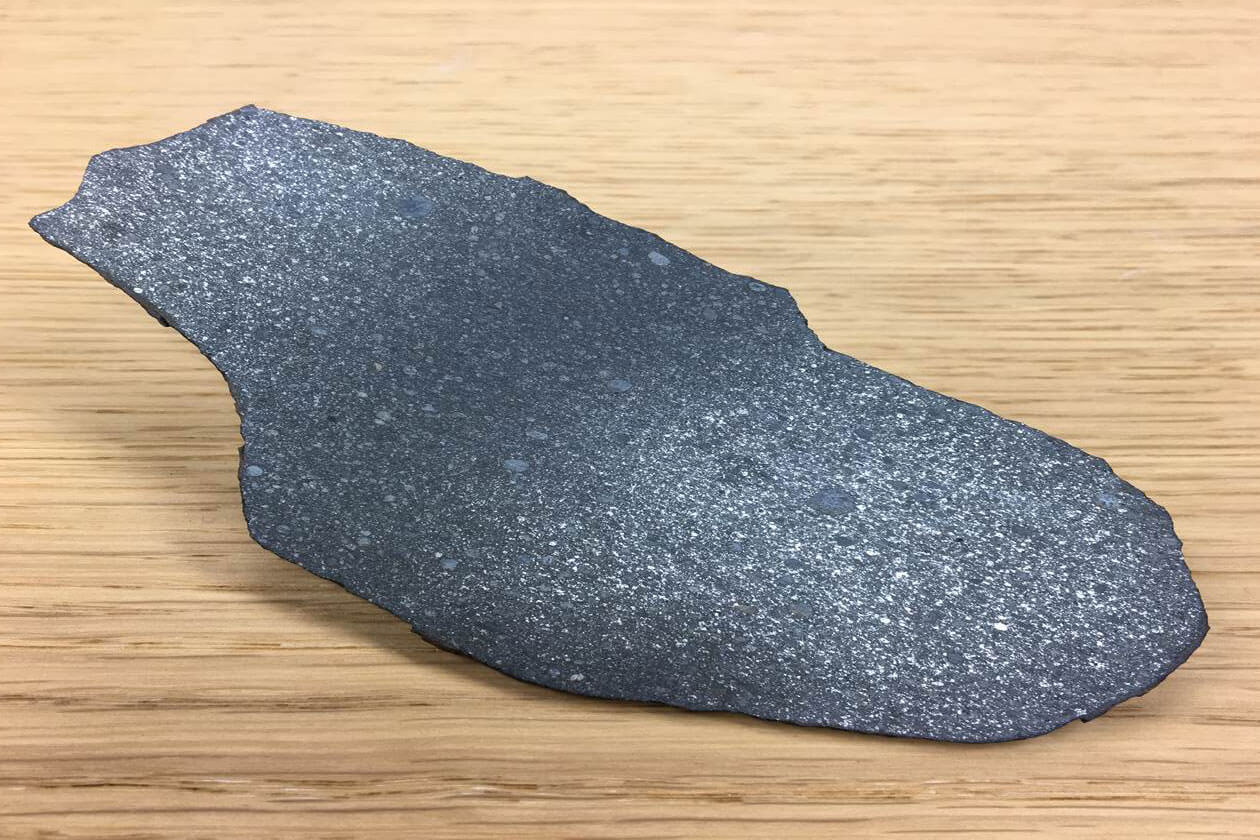
But not everyone agrees. Questions remain about the isotopic ratio of elements like tungsten, said Stewart. Tungsten-182 is derived from the hafnium-182, the ratio of tungsten to hafnium works like a clock, determining the age of a particular breed. If one breed is more tungsten-182 than the other, we can safely say that is rich in tungsten, the breed was formed early. But the most exact measurements show that the ratio of tungsten to hafnium of the Earth and the moon are the same. Two bodies were supposed to be in the special conditions for this to happen.
According to the materials of Quanta
Alternative theory: how was the Moon?
Ilya Hel